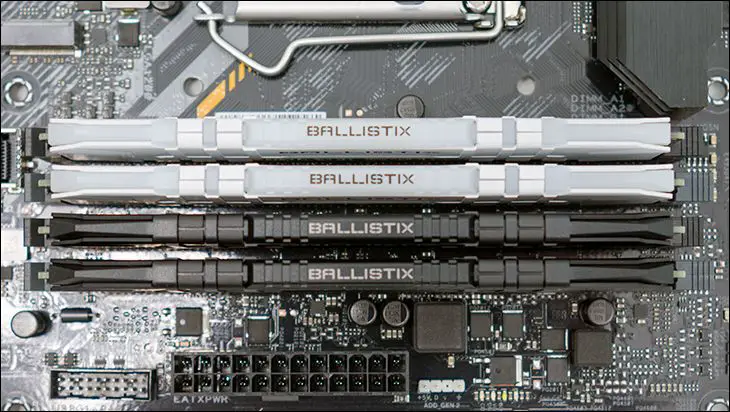

As you can see in the two photos above, both RGB and non-RGB LED equipped models use the same Micron B series RAM ICs. Some may argue that Samsung B-dies are better overclockers, but Sammy B-dies are rare these days… and these Micron B’s overclock rather well. Put bluntly, they are in the sweet spot of performance vs. price and are a great overall value. Just understand that you are not going to turn of kit of DDR4-3200 into a kit of DDR4-4000. Put another way, the Micron B’s are a great option for 32GB sticks of RAM as you are not going to be overclocking the heck out of them, and for moderate overclocking adventures (assuming your CPU’s IMC is up to the task) they are excellent choices.

On the overclocking front there are a few key takeaways. Firstly, do not worry if these kits are not on your motherboard’s QVL list. Crucial does a ton of inhouse testing to ensure compatibility. So much testing that we trust them more than the motherboard manufacture to get it right. Get it right the first time, every time. Next, the included XMP profile ‘just work’. It worked perfectly on Intel 10th generation Z490 systems, AMD Ryzen AM4 X570 and B550 systems. It worked fine on Intel HEDT X299 systems. It even worked perfectly with ThreadRipper sTRX4 based systems. This was with mix and matching both LED and non-LED models. They all just worked. Plug and play ease of use is what you will get. Plug them in, turn XMP on, reboot. Enjoy.

The only minor issue is that it is for 2T timings. This is to be expected and is in keeping with Crucial and Ballistix’s conservative nature. The fact of the matter is these mega-sticks are pretty much two sticks in one (i.e. they are Dual Rank not Single Rank). So even on quad channel systems it is somewhat like running 8 sticks of RAM. With that said, via overclocking, one of our ThreadRipper’s allowed us to hit 1T and 15-16-16 timings. It was unexpected. It was a golden CPU with a golden IMC. Do not expect 1T timings. Always worth a try, but do not worry over 1T vs 2T as these kits are all about capacity. If you really need to shave a few nanoseconds… 32GB RAM sticks are not for you.

On Intel HEDT front, things are pretty much what we expected. A wee bit of headroom on one of our Intel HEDTs but for the most part expect DDR4-3200. With that said you can easily tighten up the timings. If you are like us it is a bit of a “six in one, half dozen in the other” type deal on whether you opt for a smidgen more speed or tighter timings. Basically CL15 (and possibly CL14) is doable, and DDR4-3333 might be an option. One provides a wee bit less latency (CL14 at DDR4-3200 is 8.75ns vs 9.6ns with DDR4-3333 at CL16… for those interested the calculation is [(CL / transfer rate in MHz) x 2000
), the other a wee bit more memory bandwidth (e.g. for quad channel systems DDR4-3200 offers a theoretical bandwidth 102.4GB/s vs. 106.66GB/s… for those interested the calculation is [(64bits x # channels x transfer rate in MHz) / 8 (to convert bits to bytes)
though the easiest way is to grab the industry name and multiple it by number of channels as they have done the math for you).
If we wanted to push the voltage even higher than 1.400v we fully expect that would could have tightened things up to CL14. We chose not too as LED equipped versions do have a wee bit of vampiric load even when the LEDs are off and the LED controller is idle. This would have meant dialing in the voltages for each channel and probably is not worth the effort for most. As such, we do not recommend mixing and matching like we did. Stick to one or the other, with the non-LEDs having a bit more voltage headroom than the LED versions.









